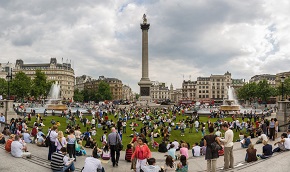Space
In very general terms, ‘space’ is an abstract term which tends to refer to a location which has not had a specific human value or purpose attached to it. This is as opposed to a ‘place’ which has an identifiable character, or a ‘location’ which has geometrical certainty.
Designers sometimes refer to 'negative space' as the space between and around objects such as buildings.
A public space is an area that tends to be open and accessible to all people. This includes roads, pavements, town squares, parks, beaches, and to a more limited extent public buildings such as town halls and libraries. The term 'common land' is sometimes used to refer to land in public ownership or to which everyone has access. To have such status, land must be legally registered as a common.
Privately-owned 'public' spaces are also a common feature of urban developments.These are spaces that are open to the public but owned and maintained by a private company. In some cases, this has been criticised for removing space from the public realm, with owners sometimes applying more rules and restrictions than there would otherwise be. Those in favour however argue that, in many cases, it can involve the improvement and regeneration of spaces that were previously neglected or poorly-used.
Space can also refer to a specific area or volume within a building, such as; useable and un-useable space, storage space, teaching space, and so on.
There are a number of guidelines, standards and regulations for the sizes of specific spaces. For example, in 2015, the government published the Technical housing standards - nationally described space standard which replaced existing space standards used by local authorities. This standard deals with internal space within new dwellings and sets out requirements for the gross internal floor area of new dwellings at a defined level of occupancy as well as floor areas and dimensions for key parts of homes.
For more information see: Technical housing standards - nationally described space standard.
Other articles relating to space on Designing Buildings Wiki include:
- Accessibility in the built environment.
- Bedroom standard.
- Bedspace.
- Building spaces.
- Conservation areas and protecting open space.
- Local green space.
- Minimum bedroom size proposals.
- Minimum space standards.
- NHBC technical standards.
- Placemaking.
- Public space intervention.
- Office space planning.
- Open space definition.
- Space classifications for lighting controls.
- Space planning.
- Terraced houses and the public realm.
[edit] Related articles on Designing Buildings Wiki
Featured articles and news
Professional practical experience for Architects in training
The long process to transform the nature of education and professional practical experience in the Architecture profession following recent reports.
A people-first approach to retrofit
Moving away from the destructive paradigm of fabric-first.
International Electrician Day, 10 June 2025
Celebrating the role of electrical engineers from André-Marie Amperè, today and for the future.
New guide for clients launched at Houses of Parliament
'There has never been a more important time for clients to step up and ...ask the right questions'
The impact of recycled slate tiles
Innovation across the decades.
EPC changes for existing buildings
Changes and their context as the new RdSAP methodology comes into use from 15 June.
Skills England publishes Sector skills needs assessments
Priority areas relating to the built environment highlighted and described in brief.
BSRIA HVAC Market Watch - May 2025 Edition
Heat Pump Market Outlook: Policy, Performance & Refrigerant Trends for 2025–2028.
Committing to EDI in construction with CIOB
Built Environment professional bodies deepen commitment to EDI with two new signatories: CIAT and CICES.
Government Grenfell progress report at a glance
Line by line recomendation overview, with links to more details.
An engaging and lively review of his professional life.
Sustainable heating for listed buildings
A problem that needs to be approached intelligently.
50th Golden anniversary ECA Edmundson apprentice award
Deadline for entries has been extended to Friday 27 June, so don't miss out!
CIAT at the London Festival of Architecture
Designing for Everyone: Breaking Barriers in Inclusive Architecture.
Mixed reactions to apprenticeship and skills reform 2025
A 'welcome shift' for some and a 'backwards step' for others.






















